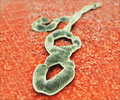Scientists have identified two biochemical pathways-PI3 kinase pathway and the CAMK2 pathway-that are vital for Ebola virus infection.
Two biochemical pathways that are vital for Ebola virus infection - PI3 kinase pathway and the CAMK2 pathway- have been identified by researchers.
For the study, the researchers the University of Texas Medical Branch at Galveston used substances that block the activation of those pathways, and prevented Ebola infection in cell culture experiments.In this way they potentially offered a critical early step in developing the first successful therapy for the deadly virus.
Ebola inflicts severe and often fatal hemorrhagic fever on its victims, producing 90 percent mortality rates in some outbreaks, but to date no vaccine exists for the virus, and it is considered a high-risk agent for bioterrorism.
Robert Davey, lead author of the study, said that they took a new approach to stopping viral infection, using powerful new computational and analytical techniques to focus more on the host cell than the virus.
"The premise for this work is that the virus is essentially nothing without a cell. It needs to rely on many cell proteins and factors for it to replicate. The idea is that if we can suppress the expression of those cell proteins for just a short time, we can then stop the disease in its tracks," he said.
For spotting the critical proteins, the researchers first conducted large-scale screening experiments using sets of cells treated with small interfering RNA (siRNA) to block 735 different genes that might produce proteins important to Ebola infection.
Advertisement
"We got a number of hits, quite a lot of places where the virus wasn't infecting the cells. The problem was then to understand what those hits meant," said Davey.
Advertisement
After subjecting that output to further computational analysis, they found that two networks of biochemical reactions seemed particularly important to Ebola's entry into cells: The PI3 kinase pathway and the CAMK2 pathway.
The above accomplishment could lead to first therapy for deadly disease.
Source-ANI
TAN










